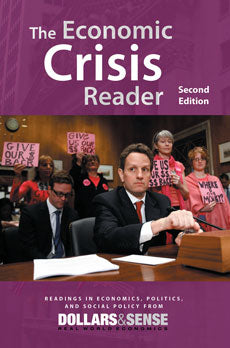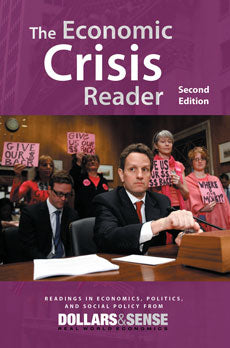Dollars & Sense Bookstore
The Economic Crisis Reader (2nd edition)
The Economic Crisis Reader (2nd edition)
Couldn't load pickup availability
Edited by Gerald Friedman, Fred Moseley, Chris Sturr, and the Dollars & Sense collective
The mainstream pundits tell us that “no one” anticipated the massive economic shocks of the past few years. The Economic Crisis Readerdebunks that myth and many other misdiagnoses of the current crisis. With more than 60 well-researched, clearly written articles, this lively reader explains the causes, consequences, and possible solutions to the ongoing economic crisis. Chapters focus on the housing boom and bust, the financial meltdown, Fed policy, fiscal stimulus, the impact on workers, global dimensions, and more. The updated second edition includes the latest news and analysis, including thought-provoking ideas for reforming our economic system to prevent similar crises in the future.
Praise for The Economic Crisis Reader:
“The Economic Crisis Reader is another exceptional collection of essays about important subjects from the venerable Dollars & Sense. A first-class group of economists and journalists cover every aspect of the most severe economic collapse since the Great Depression: the causes of the crisis, the events leading up to it, its impact on working people and their responses to it, the ins-and-outs of financial markets, the U.S. government’s inadequate responses to the crisis, international dimensions, and numerous suggestions for the reforms of and more radical changes in our economic system that would avoid such crises in the future. Every chapter is clearly written, and even the most complex topics—from mortgage-backed securities and credit default swaps to the mechanics of monetary policy and the crowding-out effect—are made eminently comprehensible. This book should be used in every undergraduate economics class in every college in the world and in every worker-education course and study group. Teachers, including especially those who have been preaching economic orthodoxy, had better read it too!” —MICHAEL YATES, author of The ABCs of the Economic Crisis: What Working People Need to Know and Associate Editor, Monthly Review
“This is distinguished public service. The Economic Crisis Reader brings together many short essays by those who were actually in the right as the crisis unfolded, as well as useful and accessible analysis from a left perspective. This effort is worth a truckload of recent mainstream journal articles.” —JAMES K. GALBRAITH, Professor, LBJ School of Public Affairs, the University of Texas at Austin, and author of The Predator State: How Conservatives Abandoned the Free Market and Why Liberals Should Too
“My students absolutely loved The Economic Crisis Reader. It was adopted for the course titled "Economic Crisis" (300-level). Based on student evaluations, the course was a great success, and students commented that they really liked the selection of articles in the Crisis Reader. They even mentioned that they read many articles that weren't even assigned on the syllabus. Thanks for producing great books for our students!” —ALLA SEMENOVA, Department of Economics, Dickinson College
“This is a book full of unexpected little jewels. Readers will find just the right fit. The range of themes and materials is all-encompassing. Every structural aspect of the dodgy, pillaging, rentier U.S. economy is explained, detailed, and assessed. To their credit, heterodox analysts—most particularly by the stalwart contributors to this impressive, timely collection—anticipated the current crisis....Talent seems to be in excess supply at Dollars & Sense: 30 authors, many well-known and the rest soon to be, take on the thorniest and often most abstruse issues. They do all this with aplomb, swift dispatch and, should we say, economy. This book will stand the test of time. It will be one of a small handful of classics revealing the savage rot of neoliberalism, the arrogant complacency of mainstream neoclassical economists, and the enabling contemporary economic policies at the Federal Reserve, the Treasury, and the Congress that have brought the U.S. to its current, ugly, impasse.” —JAMES CYPHER, Research Professor, Doctoral Program in Development Studies, Universidad Autónoma de Zacatecas, Mexico
TABLE OF CONTENTS
-
Chapter 1: General Explanations
- 1.1 The Greed Fallacy
Arthur MacEwan - 1.2 Inequality, Power, and Ideology
Arthur MacEwan - 1.3 Recession, Depression, Repression: What’s in a Name?
John Miller - 1.4 That ’70s Crisis
Alejandro Reuss - 1.5 Crisis and Neoliberal Capitalism
David Kotz - 1.6 Capitalism Hits the Fan
Richard D. Wolff - 1.7 We’re All Minskyites Now
Robert Pollin - 1.8 The “Credit Tsunami”
Steve Keen - 1.9 Profits, the Business Cycle, and the Current Crisis
Paul Mattick - 1.10 Same Output + Fewer Hours = Economic Crisis?
Alejandro Reuss - 1.11 Why Won’t the Economy Spring Back?
James M. Cypher
- 1.1 The Greed Fallacy
-
Chapter 2: Warning Signs
- 2.1 Bubble Trouble
Dean Baker - 2.2 A House of Cards
Tamara Draut and Adria Scharf - 2.3 (Mis)Understanding a Banking Industry in Transition
William K. Black - 2.4 America’s Growing Fringe Economy
Howard Karger - 2.5 Financialization: A Primer
Ramaa Vasudevan - 2.6 Private Equity Exposed
Orlando Segura, Jr. - 2.7 Hedge Funds
Arthur MacEwan - 2.8 The Fed and America’s Distorted Expansion
Thomas I. Palley - 2.9 Who Cares If Bear Stearns Fails?
Arthur MacEwan - 2.10 Can the Fed Handle a Systemic Crisis? Maybe.
Jane D’Arista
- 2.1 Bubble Trouble
-
Chapter 3: The Housing Bubble and Bust
- 3.1 The Homeownership Myth
Howard Karger - 3.2 What Were the Bankers Thinking?
Arthur MacEwan - 3.3 Renters in the Crosshairs
Daniel Fireside - 3.4 How to Stop the Foreclosures
Fred Moseley - 3.5 The Bailout of Fannie Mae and Freddie Mac
Fred Moseley - 3.6 Who Gets Those Trillions?
Arthur MacEwan - 3.7 Don’t Blame the CRA
Jim Campen - 3.8 Update on Mortgage Lending Discrimination
Jim Campen
- 3.1 The Homeownership Myth
-
Chapter 4: The Financial Meltdown
- 4.1 From Tulips to Mortgage-Backed Securities
Gerald Friedman - 4.2 Ponzi Schemes and Speculative Bubbles
Arthur MacEwan - 4.3 Confidence Trick
John Miller - 4.4 Derivatives and Deregulation
Marty Wolfson - 4.5 Dealing with a Rotten Tooth
Arthur MacEwan - 4.6 Time for Permanent Nationalization!
Fred Moseley - 4.7 Trust Your Gut
William Greider - 4.8 Not Too Big Enough
Rob Larson - 4.9 Bonanzas as Usual
Rob Larson - 4.10 The Sad Future of Banking
William K. Black
- 4.1 From Tulips to Mortgage-Backed Securities
-
Chapter 5: Monetary Policy: The Fed and The Money Supply
- 5.1 Pushing on Strings
Gerald Friedman - 5.2 Bernanke’s Bad Teachers
Gerald Friedman - 5.3 The Bailouts Revisited
Marty Wolfson - 5.4 Of Bubbles and Bailouts
Mary Bottari - 5.5 Fixing the Fed
William Greider - 5.6 Keynes and the Limits of Monetary Policy
Alejandro Reuss - 5.7 Bad News, Good News, and Class Conflict
John Miller - 5.8 Pressure from the Bond Market
Arthur MacEwan
- 5.1 Pushing on Strings
-
Chapter 6: Fiscal Policy: Stimulus and Deficits
- 6.1 Stimulating Whining
John Miller - 6.2 How I Learned to Stop Worrying and Love the Deficit
John Miller - 6.3 Responding to Revisionism
Gerald Friedman - 6.4 Fiscal Policy and “Crowding Out”
Alejandro Reuss - 6.5 Why Are Things Getting Worse and Worse?
Arthur MacEwan - 6.6 The Economic Crisis in the States
Gerald Friedman - 6.7 State Budget Blues
Marianne Hill - 6.8 Myths of the Deficit
Marty Wolfson - 6.9 The Deficit: Real Issue, Phony Debates
Rick Wolff
- 6.1 Stimulating Whining
-
Chapter 7: The Jobs Crisis
- 7.1 The Real Unemployment Rate Hits a 68-Year High
John Miller - 7.2 Unemployment: How Bad for How Long?
Fred Moseley - 7.3 Unemployment Insurance: A Broken System
Marianne Hill - 7.4 Employers Go on Strike Because They Can
John Miller - 7.5 Gender and the Recession
Heather Boushey - 7.6 A Dismal Time to Graduate
Katherine Faherty - 7.7 How Blacks Might Fare in the Jobless Recovery
Sylvia Allegretto and Steven Pitts
- 7.1 The Real Unemployment Rate Hits a 68-Year High
-
Chapter 8: Industrial and Employment Policy
- 8.1 Bail Out the Safety Net
Randy Albelda - 8.2 Creating Decent Jobs
Jeannette Wicks-Lim - 8.3 Is Military Keynesianism the Solution?
Heidi Garrett-Peltier - 8.4 We Need a (Green) Jobs Program
Jeannette Wicks-Lim - 8.5 Saving Energy Creates Jobs
Heidi Garrett-Peltier - 8.6 Eighteen Million Jobs by 2010
Robert Pollin - 8.7 A New WPA?
Ryan A. Dodd - 8.8 Changing the Auto Industry from the Wheels Up
Alejandro Reuss
- 8.1 Bail Out the Safety Net
-
Chapter 9: Labor Activism
- 9.1 The Global Crisis and the World Labor Movement
Dan LaBotz - 9.2 The Real Audacity of Hope
Kari Lyderson and James Tracy - 9.3 Corporate America’s Counter-Stimulus Strategy
Roger Bybee - 9.4 Worker Direct Action Grows in Wake of Financial Meltdown
Immanuel Ness and Stacy Warner Maddern - 9.5 Greece as a Demonstration Project
Mike-Frank Epitropoulos - 9.6 Should We Be Talking About Living Wages Now?
Jeannette Wicks-Lim - 9.7 On Strike in China
Chris Tilly and Marie Kennedy
- 9.1 The Global Crisis and the World Labor Movement
-
Chapter 10: The International Crisis
- 10.1 The Giant Pool of Money
Arthur MacEwan - 10.2 W(h)ither the Dollar?
Katherine Sciacchitano - 10.3 Putting the “Global” in the Global Economic Crisis
Smriti Rao - 10.4 (Economic) Freedom’s Just Another Word for...Crisis-Prone
John Miller - 10.5 Tax Havens and the Financial Crisis
Rachel Keeler - 10.6 Beyond the World Creditors’ Cartel
Dariush Sokolov - 10.7 No Bailout for AIDS
Mara Kardas-Nelson - 10.8 The Beijing Statement
- 10.9 The Caracas Statement
- 10.1 The Giant Pool of Money
Date of publication: November 2010
ISBN: 978-1-878585-84-4
Pages: 411
Share


